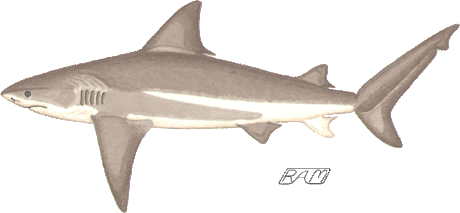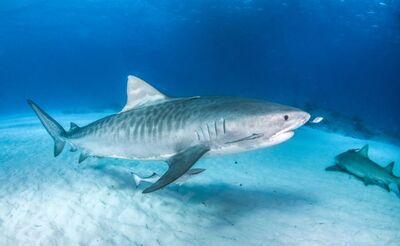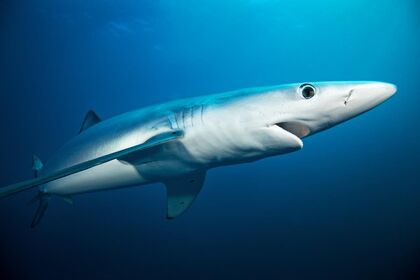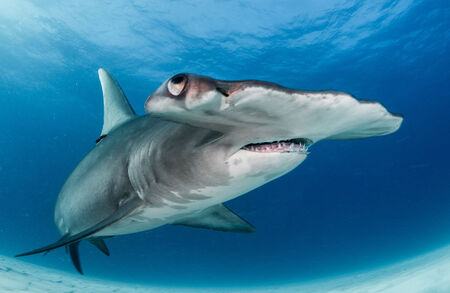
Ref: http://www.elasmo-research.org/education/ecology/id-heterodontiformes.htm
Defining Features[]
More commonly known as the groundsharks, Carcharhiniformes are the largest order of sharks. They possess 5 gill slits, movable eyelids, 2 spineless dorsal fins, and an anal fin. Additionally, their mouths are filled with sharp teeth and stretch behind the front of their eyes. Carcharhiniformes have a generally short and blunt snout. They have triangular and sharp teeth with small cusps that are replaceable. in fact, most Carcharhiniformes shed over 30000 teeth in their lifetimes. If anything, Carcharhiniformes appear to be the most traditional looking shark out of the different orders.
Habitat and Range[]
Carcharhiniformes have a wide habitat range. They can be found anywhere ranging from estuaries, to coral reefs, to the intertidal and open ocean. None are specialized to be a bottom dweller, but 2 species reach down to 2,000 feet below sea level and 3 are oceanic.
Fisheries Conservation and Concern[]
31 species of Carcharhiniformes are either critically endangered, endangered, vulnerable, or at a low risk. Despite this, Carcharhiniformes remain the dominant order of sharks. Carcharhiniformes are fished intensely both for food and recreational purposes.
Closest Relatives[]
Carcharhiniformes is most closely related to bullhead (Heterodontiformes), carpet (Orectolobiformes), and mackerel sharks (Lamniformes). These orders belong to the superorder Galeomorphii that contains all modern sharks with the exception of the dogfish and its relatives.
Example Species in Carcharhiniformes[]
Tiger shark[]

Ref: https://www.americanoceans.org/species/tiger-shark/
Galeocerdo cuvier[]
Defining Features: With a relatively short and rounded snout, the tiger shark is known for the dark vertical stripes that can be found on the sides of juveniles. Other features include a large dorsal fin, long labial furrows, and teeth with curved and serrated cusps. Large females have been known to reach upwards of 19.7 feet long.
Range & Habitat: The tiger shark can mostly be found in warm, inshore waters in continental areas or in isolated oceanic islands at the intertidal range down to around 459 feet below sea level.
IUCN Concern: As of August 10, 2018, the Tiger shark is listed by the IUCN as near threatened, with the population appearing to be decreasing.

Ref: https://oceana.org/marine-life/sharks-rays/blue-shark
Blue shark[]
Prionace glauca[]
Defining Features: As its name suggests, this shark has a bright to dark blue coloring. It has a slim and slender body ending with a lengthy snout. From its sides protrude curved pectoral fins. Additionally, their teeth are curved and also saw edged Fully grown males may reach up to 9.2 feet in length while females may reach up to 7.2 feet.
Range & Habitat: The Blue shark can be found in tropical and temperate area at latitudes from 60 degrees North to 50 degrees south. They generally stay around 350 meters below sea level and above and prefer cooler temperatures at around 12-20 degrees Celsius.
IUCN Concern: As of August 14, 2018, the Blue shark is listed by the IUCN as near threatened with a decreasing population trend.
Example Species in the Gulf of Maine[]

Ref: http://divemagazine.co.uk/travel/8248-hammerhead-shark-species
Hammerhead shark[]
Sphymidae[]
Defining Features: With a head uniquely shaped like a hammer, Sphymidae is one of the most recognizable sharks in the world. Other notable details include circular eyes on either side of the cephalofoil, a large dorsal fin, and lengths ranging from 10 to 17 feet.
Range & Habitat: Hammerheads are located in coastal and offshore waters in continental and insular areas. They can typically be found at the surface of the water or so far down as 900 feet below sea level. They live in warm and tropical seas.
IUCN Concern: IUCN ranks the great hammerhead as critically endangered with the population decreasing as of November 9, 2018.
References[]
https://www.sharks.org/species
https://www.pbs.org/wgbh/nova/sharks/world/carcharhiniformes.html
http://www.elasmo-research.org/education/ecology/sea_change.htm
https://www.iucnredlist.org/ja/species/39378/2913541
https://www.iucnredlist.org/ja/species/39386/2920499
https://www.iucnredlist.org/species/39381/2915850
https://www.floridamuseum.ufl.edu